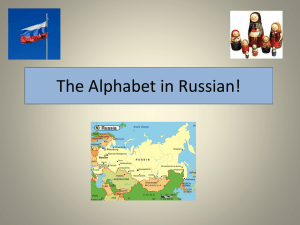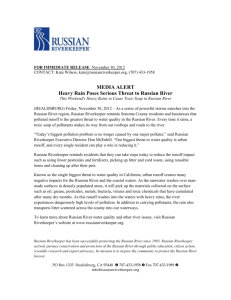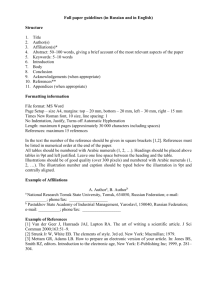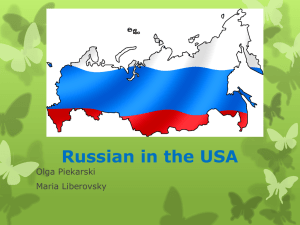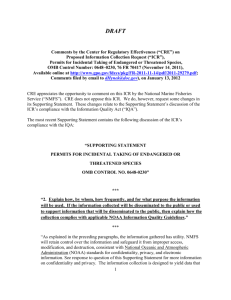Work Plan Outline SCC APPROVED June 21, 2012
advertisement
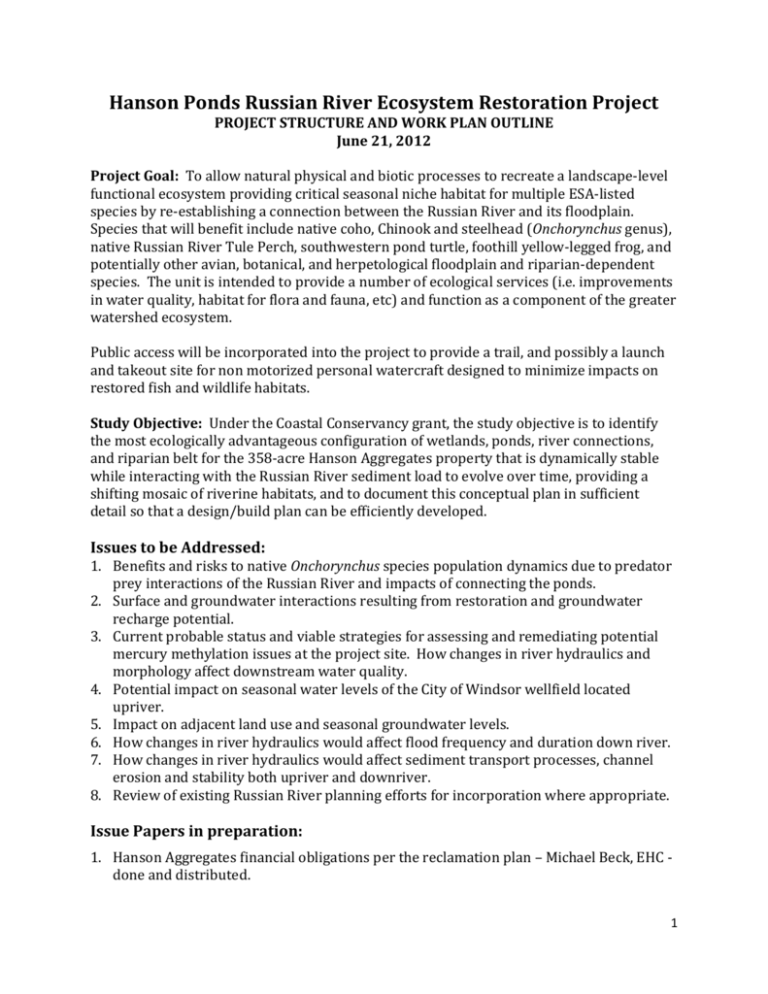
Hanson Ponds Russian River Ecosystem Restoration Project PROJECT STRUCTURE AND WORK PLAN OUTLINE June 21, 2012 Project Goal: To allow natural physical and biotic processes to recreate a landscape-level functional ecosystem providing critical seasonal niche habitat for multiple ESA-listed species by re-establishing a connection between the Russian River and its floodplain. Species that will benefit include native coho, Chinook and steelhead (Onchorynchus genus), native Russian River Tule Perch, southwestern pond turtle, foothill yellow-legged frog, and potentially other avian, botanical, and herpetological floodplain and riparian-dependent species. The unit is intended to provide a number of ecological services (i.e. improvements in water quality, habitat for flora and fauna, etc) and function as a component of the greater watershed ecosystem. Public access will be incorporated into the project to provide a trail, and possibly a launch and takeout site for non motorized personal watercraft designed to minimize impacts on restored fish and wildlife habitats. Study Objective: Under the Coastal Conservancy grant, the study objective is to identify the most ecologically advantageous configuration of wetlands, ponds, river connections, and riparian belt for the 358-acre Hanson Aggregates property that is dynamically stable while interacting with the Russian River sediment load to evolve over time, providing a shifting mosaic of riverine habitats, and to document this conceptual plan in sufficient detail so that a design/build plan can be efficiently developed. Issues to be Addressed: 1. Benefits and risks to native Onchorynchus species population dynamics due to predator prey interactions of the Russian River and impacts of connecting the ponds. 2. Surface and groundwater interactions resulting from restoration and groundwater recharge potential. 3. Current probable status and viable strategies for assessing and remediating potential mercury methylation issues at the project site. How changes in river hydraulics and morphology affect downstream water quality. 4. Potential impact on seasonal water levels of the City of Windsor wellfield located upriver. 5. Impact on adjacent land use and seasonal groundwater levels. 6. How changes in river hydraulics would affect flood frequency and duration down river. 7. How changes in river hydraulics would affect sediment transport processes, channel erosion and stability both upriver and downriver. 8. Review of existing Russian River planning efforts for incorporation where appropriate. Issue Papers in preparation: 1. Hanson Aggregates financial obligations per the reclamation plan – Michael Beck, EHC done and distributed. 1 2. Flood, river capture, channel dynamics and evolution issues – Brian Cluer, NMFS Fluvial Geomorphologist, in draft. 3. Impact of niche seasonal floodplain habitat and the predator prey interactions likely to affect ESA-listed native anadromous Pacific salmonid species’ population dynamics – John P. McKeon, NMFS Natural Resource Management Specialist, in draft. 4. Water quality issues (e.g., nutrients, suspended sediment, heavy metal accumulation/production and phytoplankton dynamics), likely to impact water quality. The paper will likely focus on an assessment of contrasting reclamation and restoration scenario benefits and risks associated with the movement of mercury through food web trophic levels with a focus on salmonids. – Melanie Harrison, NMFS Wetland Chemist /Limnologist, in draft. Project Structure: Project Team: Primary role is day-to-day project oversight - EHC (Michael Beck, Nancy Schaefer), NOAA/NMFS (John McKeon, Brian Cluer, Melanie Harrison), DFG (Ryan Watanabe), Coastal Conservancy (Michael Bowen). Proposed Local Partner: Primary role is stakeholder outreach – Russian Riverkeeper and Sotoyome Resource Conservation District. Partners Planning Group (names are suggestions): Purpose is to keep partners informed and to solicit their input and guidance. Members are the Project Team plus Sonoma County PRMD (Jennifer Barrett, Amy Lyle), DFG (Derek Acomb, Mike Berry, Adam McKannay), Sonoma County Parks (Caryl Hart, Ken Tam, Mark Cleveland), Sonoma County Open Space District (Karen Gaffney), Sonoma County Water Agency (Jay Jasperse), City of Windsor (Jim Bergman, Richard Burtt), Ducks Unlimited, Redwood Empire Trout Unlimited, Russian Riverkeeper, Russian River Wild Steelhead Society (Bob Torre), Sotoyome Resource Conservation District (Kara Heckert), CalTrout (Darren Mierau). Scientific and Technical Working Group: Purpose is to define and reconcile sciencebased project objectives, and standards, review and advise within iterations, and assist in framing the Resource Management and Monitoring Plan. Suggested members include Project Team and the following: Ecologists– Melanie Harrison (NMFS), Peter Baye, John McKeon (NMFS) Fisheries specific ecologists- Tim Beechie NMFS NWFSC, Sean Hayes NMFS SWFSC, John McKeon, NMFS Santa Rosa, SWR PRD. Fluvial Geomorphologist - Brian Cluer, NMFS Santa Rosa, SWR HCD. Sediment Transport and Landscape Evolution - Jon Nelson, USGS Denver SMARA expert- Warren Coalson, EnviroMine Licensed Engineer – Wayne Chang, Chang Consultants Hydrologist – groundwater/surface water interaction –DWR? Restoration Ecologist – Leslie Bach, Nature Conservancy (Portland, OR) Historical Ecology, Robin Grossinger, San Francisco Estuary Institute 2 Brock Dolman, Occidental Arts and Ecology Center Planner, Greg Carr Peer Review Panel – to be engaged prior to model runs and after results of model runs have been drafted and the preferred alternative selected. Fisheries biologist, Peter Moyle, PhD, UC Davis, Guillermo Giannico, PhD, Oregon State, Vegetation ecologist, Peter Bayley, PhD from Oregon State Fluvial geomorphologist, Herve Piegay, Research Director, National Center for Scientific Research (CNRS), France. Restoration ecologist, Phil Williams, PhD (Construction engineer) Sediment transport modeler - USGS Colleagues? Stakeholders: This is the list of landowners, environmental groups, farm groups and others that will be the subject of the Sotoyome RCD and Russian Riverkeeper outreach strategy and work. Purpose is to engage and inform– Audubon chapter, Sierra Club chapter, landowners, Russian River Watershed Council, Lytton Tribe, Ducks Unlimited, West Side Association to Save Agriculture (WASA), Farm Bureau, Dry Creek Valley Association, Russian River Property Owners Association, and others that may be identified. EHC will work with Sotoyome Resource Conservation District and Russian Riverkeeper on an outreach strategy for this group. Hanson Russian River Work Plan Outline: 1. Outreach Strategy. Develop and implement outreach strategy with input from Sotoyome RCD and Russian Riverkeeper. 2. Partners Planning Group Meeting 1. Hold Partners Planning Group meeting to review work plan, approach, methodology, and proposed outreach strategy. 3. Stakeholders Workshop. Hold stakeholders public workshop with assistance and guidance from Sotoyome RCD and Russian Riverkeeper. The goal of the public meeting will be to present the project, answer questions, understand local concerns and solicit stakeholder feedback and knowledge about the affects and value of the proposed study. 4. Reclamation Plan Amendment. Submit application for Reclamation Plan Amendment if PRMD determines this is necessary. 5. LIDAR Survey. County completes a LIDAR survey of the 8 miles of the Middle Reach of the Russian River including the floodplain. 6. Phase I Environmental Site Assessment with Soil and Water Sampling. Hire consultant (EEI, Inc) to complete Phase I Environmental Site Assessment and to do soil testing of fill material. Consultant will coordinate with Affiliated Researchers who will be doing the sediment sampling. 3 7. Literature and Data Search. Direct consultant or NOAA/NMFS to conduct a literature search, and an assimilation of literature and data pertaining directly to the project scope. This task should be limited in scope and assisted by the Partners Planning Group in order to minimize cost and time. Particular attention should be focused on the following: a. Assemble and collate available topographic and bathymetric data sets of the entire floodplain topography for 8 miles of the Middle Reach of the Russian River. b. Identify areas where data are not already available and where significant uncertainty (relative to the modeling needs) exist, 8. Literature and Data Search Circulation. Circulate literature search and assimilation to Partners Planning Group and Scientific and Technical Working Group to determine key data gaps warranting further data collection. 9. Data Collection. Finalize scope of work, with consultant to complete the tasks listed below. Present draft scope of work to Partners Planning Group. a. To fill data gaps, collect topographic and bathymetric data sets for 8 miles of the Russian of the entire floodplain topography. b. Establish monumented survey points to supplement and verify the existing datasets of above-water topography, and to inform the sediment stratigraphy item. c. Complete topographic and bathymetric surveys, sediment and water quality sampling for the four Hanson ponds. 10. Sediment Sample Analysis and Model Calibration. Brian Cluer and other NMFS staff complete the following: a. sample grain size distributions throughout the river reach, and b. collect model calibration datasets, including water surfaces and river velocities distributions during 2-3 key flow levels 11. Convene Scientific and Technical Working Group (Meeting 1). Convene group for day-long meeting when all existing data has been compiled and new data gathered including topographic, bathymetric and soils maps are ready, to discuss desired wetland landscape features and assumptions using 4 scenarios as a framework for possible refinement. Include discussion of reclamation plan phase for the project. The Four Scenarios are: 1. Existing Conditions. Existing channel connection and no reinforcement of the river levee. 2. Reclamation Plan. Current reclamation plan, with reinforced levee at Richardson Pit at certain height, and the existing backflow connection, and with little change in topography. 4 The next two scenarios explore the bounds of fluvial stability and ecological superiority and are intended to bracket the range of the re-connection options. 3. Seasonally Interconnected Ponds and Floodplain. Large-scale earthwork to uplands between ponds and next to river, so the lowered land is supportive of riparian vegetation rather than upland. Interconnecting ponds and river so that fish have access from the river to the ponds during the wet season but not during the dry season. 4. Floodplain Wetland Complex. Large-scale earthwork to reshape all available material between the pits and between the river and pits. Push materials into the pits to shallow undesirable depths and to create shoals at productive elevations. Create broad low channels between pits and between pits and river, and set up pathways for the river to meander, migrate, and interact with the entire landscape to the maximum possible extent. This scenario is likely the highest stress on river stability because it can transfer to storage the greatest percentage of the river’s bedload. This scenario will be explored to find the maximum extent of river/pit interaction that would correspond to triggering additional bed degradation, which is not reasonable to propose. This scenario will guide just how low and extensive the river/pit connections can be. 12. Partners Planning Group Meeting 2. Convene Partners Planning Group meeting with Jon Nelson, USGS, to present model and answer questions, review data and assumptions. The goal of the modeling project is to set up scenarios that bracket the widest range of possible alternative land configurations, to explore the benefits of relatively modest earthwork as well as aggressive land reforming that may be ecologically superior. The discussion will also include potential locations for trails and a kayak takeout. 13. Peer Review Panel Meeting 1. Peer Review Panel reviews data and methodology as informed by the Scientific and Technical Working Group via Webex session depending on funding. 14. River Re-connection Scenarios Modeling. Jon Nelson (USGS) runs the model for the 4 scenarios as informed by Scientific and Technical Working Group and Peer Review Panel input. Results sent to the Scientific Working Group and Peer Review Panel. 15. Scientific and Technical Working Group Meeting 2. Convene Scientific and Technical Working Group with Jon Nelson to select preferred alternative. Scientific and Technical Working Group assesses the four scenarios and develops proposed scenario recommendations based on analysis of the scale of seasonal niche habitat availability and overall ecological functioning, including water quality dynamics and predator prey interactions. Criteria for selection would include consideration of the most ecologically beneficial for a cost that could be likely supported by funding entities. Collectively, Scientific and Technical Working Group converges on 1 most beneficial preferred scenario. Final scenarios identify reclamation plan phase. 5 16. Run Model for Preferred Alternative. Jon Nelson runs the preferred alternative selected by the Scientific and Technical Working Group taking the status of Syar into account at that time. A draft report of the model results and predictions regarding flood and erosion risks, risks to Russian River channel stability upstream and downstream from project, groundwater changes, other physical predictions, biological effects, water quality issues, etc. is delivered to the Scientific and Technical Working Group electronically. 17. Scientific and Technical Working Group Meeting 3 and Statement of Benefits. Scientific and Technical Working Group meets by Webex to discuss final results. Working Group, EHC write up synopsis of expected benefits and risks of restoring the landscape according to the preferred scenario and expected benefits for multiple resource, educational and recreational values. The group will produce an integrated statement on the overall likely ecological contributions of the preferred scenario to the greater ecosystem of the Russian River Watershed. 18. Peer Review Panel Meeting 2. Peer Review Panel reviews analysis and synopsis of project ecosystem and watershed benefits versus projected costs and defined risks of restoration proposed. 19. Final Report and Reclamation/Restoration Plan. Finalize draft report on model results and predictions regarding flood and erosion risks, risks to Russian River channel stability upstream and downstream from project, expected seasonal groundwater effects, other likely physical, biological, water quality effects on identified issues. The report write up will include identification of a distinct reclamation plan phase, to be completed prior to full restoration as part of an early phase of overall project implementation. Using this report as the conceptual plan and design, the final reclamation/restoration plan will be developed. The location of trails and a kayak takeout (if feasible) will be included. 6

